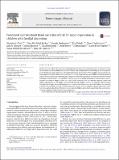Functional and structural brain correlates of risk for major depression in children with familial depression
Author(s)
Hirshfeld-Becker, Dina; Biederman, Joseph; Uchida, Mai; Doehrmann, Oliver; Kenworthy, Tara; Brown, Ariel; Kagan, Elana; Chai, Xiaoqian; Leonard, Julia Anne; Gabrieli, John D. E.; Salvatore, John J.; de los Angeles, Carlo S; Whitfield-Gabrieli, Susan; ... Show more Show less
DownloadGabrieli_Functional and.pdf (919.4Kb)
PUBLISHER_CC
Publisher with Creative Commons License
Creative Commons Attribution
Terms of use
Metadata
Show full item recordAbstract
Despite growing evidence for atypical amygdala function and structure in major depression, it remains uncertain as to whether these brain differences reflect the clinical state of depression or neurobiological traits that predispose individuals to major depression. We examined function and structure of the amygdala and associated areas in a group of unaffected children of depressed parents (at-risk group) and a group of children of parents without a history of major depression (control group). Compared to the control group, the at-risk group showed increased activation to fearful relative to neutral facial expressions in the amygdala and multiple cortical regions, and decreased activation to happy relative to neutral facial expressions in the anterior cingulate cortex and supramarginal gyrus. At-risk children also exhibited reduced amygdala volume. The extensive hyperactivation to negative facial expressions and hypoactivation to positive facial expressions in at-risk children are consistent with behavioral evidence that risk for major depression involves a bias to attend to negative information. These functional and structural brain differences between at-risk children and controls suggest that there are trait neurobiological underpinnings of risk for major depression.
Date issued
2015-05Department
Massachusetts Institute of Technology. Institute for Medical Engineering & Science; Massachusetts Institute of Technology. Department of Brain and Cognitive Sciences; McGovern Institute for Brain Research at MITJournal
NeuroImage: Clinical
Publisher
Elsevier
Citation
Chai, Xiaoqian J., Dina Hirshfeld-Becker, Joseph Biederman, Mai Uchida, Oliver Doehrmann, Julia A. Leonard, John Salvatore, et al. “Functional and Structural Brain Correlates of Risk for Major Depression in Children with Familial Depression.” NeuroImage: Clinical 8 (2015): 398–407.
Version: Final published version
ISSN
22131582